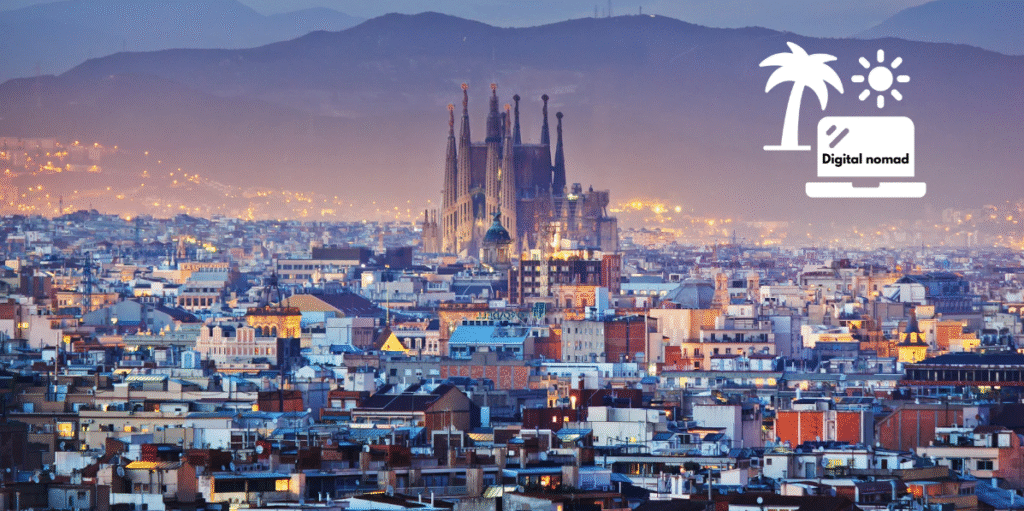Thailand offers something for every traveler, whether you're looking for sunny beaches, vibrant city...
Travel Guides
Barcelona blends Mediterranean charm with modern infrastructure, making it one of Europe’s top destinations for remote workers. With vibrant neighborhoods, fast internet, and a variety of accommodations tailored to digital nomads, the city offers an ideal environment for balancing work and lifestyle. In this guide, we’ll highlight the best places to stay in Barcelona, covering housing types, work-friendly amenities, and the most nomad-friendly districts.


Barcelona, known for its stunning architecture, art scene, and beautiful Mediterranean coastline, has become a magnet for digital nomads. The city combines a relaxed, southern European vibe with top-notch infrastructure and modern amenities, making it an ideal place to work remotely. In this article, we’ll explore the best places to stay in Barcelona as a digital nomad. We’ll include tips on what to look for, different accommodation types, top neighborhoods, and the best ways to stay connected during your stay.
When choosing where to stay in Barcelona, there are a few important things to keep in mind to make sure your remote work experience goes smoothly and feels comfortable. These include:
Barcelona offers a wide range of lodging options tailored to different lifestyles, budgets, and preferences. Let’s explore some of the most popular choices:
These modern, community-oriented accommodations combine private bedrooms with shared living areas, kitchens, and co-working zones. Coliving spaces often organize social events, workshops, or networking opportunities, creating a lively and welcoming environment where you can connect with other remote workers and locals.
They’re perfect for those wanting a good mix of privacy and community engagement. Plus, many coliving spaces provide flexible stay options to adapt to changing plans.
If you’re a digital nomad looking for a more independent and comfortable place to stay, serviced apartments or long-stay hotels are a great choice. They typically provide amenities like weekly cleaning, Wi-Fi, a small kitchenette, and sometimes even access to gyms or pools.
These spaces feel like a home away from home, offering privacy combined with convenience. They are perfect for longer stays or those who prefer a more structured environment.
Offering a taste of local life, Airbnb listings range from cozy studios to spacious city apartments. They often come fully furnished with essential amenities, allowing you to settle in quickly.
When booking, pay close attention to reviews that mention Wi-Fi speed and workspace availability. Staying in a local neighborhood on Airbnb can give you a more authentic experience of Barcelona, especially if you choose a place near cafes, markets, and green spaces.
Many hostels now include coworking spaces and private rooms, making them an affordable option. They’re a great way to connect with other travelers and remote workers while exploring the city.
Some hostels also organize social events and sightseeing tours, giving you opportunities to meet people and experience local culture.
Choosing the right neighborhood can significantly enhance your experience as a digital nomad. Barcelona’s diverse districts offer something for everyone — whether you prefer lively city scenes, peaceful green areas, or a creative, bohemian atmosphere.
Here are five popular neighborhoods in Barcelona appreciated by digital nomads:
Known for its artistic and historical charm, El Born is a favorite among creatives and young professionals. Its narrow, winding streets are lined with boutique shops, trendy cafes, and lively bars.
It's a perfect area if you enjoy being in the heart of cultural activity, with many options for casual workspaces and local food. Its proximity to the Gothic Quarter and the seaside adds to its appeal.
Famous for its grid-like streets and Modernist architecture — including Gaudí’s iconic buildings — Eixample offers a mix of residential comfort and urban convenience. This area is well-connected via public transport and has a variety of cafes, coworking spaces, and shops at your doorstep.
It’s ideal for those who prefer a more polished environment with easy access to the city’s main attractions.
Originally a separate village, Gràcia retains a relaxed, village-like atmosphere with bustling plazas, independent shops, and an artsy vibe. It’s popular among those who want a more laid-back, community-oriented experience.
Many cafes and parks here provide peaceful spots to work outdoors, and its creative energy makes it a great place for inspiration.
Located at the foot of Montjuïc, Poble Sec is an up-and-coming neighborhood that combines affordability with lively energy. It’s known for its tapas bars, local markets, and proximity to green spaces and cultural sites.
Excellent public transport links make it easy to reach the rest of the city, making it a practical choice for remote workers.
This trendy neighborhood has experienced a renaissance recently, with a lively market, cafes, and a diverse dining scene. Its mix of quiet residential streets and social hubs makes it suitable for those who want a lively atmosphere without the overwhelming tourist crowds.
The neighborhood also offers good connectivity and easy access to beaches and parks nearby.
Getting settled in Barcelona as a remote worker requires some thoughtful planning. To help you make the most of your stay, here are some practical tips:
Staying connected while traveling is vital, especially when working remotely. A Spain eSIM offers a hassle-free way to access mobile data without the need for physical SIM cards or unreliable Wi-Fi hotspots.
Here’s a quick overview of popular eSIM providers for Spain:
| Provider | Pros | Cons | Price | |
| Holafly | Unlimited data, 24/7 customer support | Limited hotspot sharing, no local phone number, | From $6.90 per day for unlimited data | |
| Maya Mobile | Unlimited plan, Wi-Fi hotspot option | No mobile app, calls and SMS not supported | From $2.52 per day for unlimited data | |
| Airalo | User-friendly app, hotspot sharing | Strict refund policy, unreliable customer support | From $4.50 for 1 GB | |
It depends on how long you stay in Spain. If you stay in Spain for more than 183 days in a year, you're generally considered a tax resident and may need to pay tax on your worldwide income. It's advisable to consult a tax professional to understand your specific situation.
As of now, Spain’s digital nomad visa typically requires proof of sufficient income, often around €2,762 per month (or €33,144 per year), though requirements can vary.
No, holding a digital nomad visa does not count toward citizenship. It’s a temporary residence permit, and to qualify for citizenship, you generally need to live in Spain continuously for at least 10 years, among other requirements.
Yes, there are no restrictions on property purchases for digital nomads or foreigners. Owning property does not automatically grant residency, but it can be a useful asset.
Some neighborhoods may be less desirable for residents due to safety concerns or lack of amenities, such as parts of La Maternitat or certain areas in the outskirts. It’s best to research neighborhoods thoroughly and consider safety, accessibility, and personal preferences before choosing a place to live.

